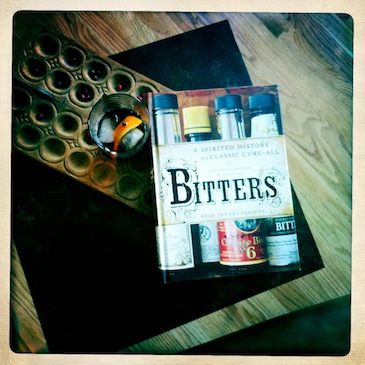Eat Your Words: Bitters: A Spirited History of a Classic Cure-All
By Roger Kamholz in Food on Nov 25, 2011 7:00PM
 Here's a Black Friday shot in the dark: you went nuclear on a bunch of turkey and stuffing and a variety of buttery whatnot last night. Chances are good that A) you're still digesting the rich and delicious and perhaps slightly regrettably sized bounty, and B) you didn't cap off your meal with a shot of bitters to aid said digestion.
Here's a Black Friday shot in the dark: you went nuclear on a bunch of turkey and stuffing and a variety of buttery whatnot last night. Chances are good that A) you're still digesting the rich and delicious and perhaps slightly regrettably sized bounty, and B) you didn't cap off your meal with a shot of bitters to aid said digestion.
Had you read author Brad Thomas Parsons's new book, Bitters: A Spirited History of a Classic Cure-All ($24.99), you might have reached for, say, an Angostura and soda to sip during your football watching and now would be far lighter on your feet for your trouble.
That's because Parsons's timely new tome provides an in-depth account of the origins, uses and benefits (both real and purported), eventual disappearance and recent resurgence of bitters. Today, bitters are increasingly employed by bartenders as concentrated flavoring agents, which can round out a cocktail and provide balance to its sweet and acidic elements. Typically alcohol-based, bitters have long been made with an array of aromatic barks, roots, fruit peels, spices, botanicals and other obscure ingredients. Before Prohibition and the Pure Food and Drug Act of 1906, creative salesmen hawked a wide variety of bitters in America as a panacea for pretty much anything that ailed you - poor digestion, dyspepsia, "liver compliant," you name it. After the government put a stop to these largely false claims, the bitters industry dried up and all but disappeared; only a couple of producers carried on through Prohibition and the rise of bitters-less cocktails like the vodka Martini.
But, as Parsons demonstrates in his thoroughly researched and well-written account, bitters are suddenly back. With the current revival of craft cocktail culture has come a renewed interest in bitters (which appeared in dozens of 19th century drink recipes). And the market for bitters is starting to rival its former breadth. Parsons's book not only impressively rounds up all the players in the widening bitters landscape (from the biggies like Angostura and Peychaud's Bitters to upstart companies like Milwaukee's Bittercube and Brooklyn's Bittermens), it also offers several recipes for making bitters at home as well as recipes for lots of classic and modern cocktails that call for dashes of bitters. There are even recipes for using bitters to liven up food, like Sweet & Spicy Bitter Bar Nuts. For the budding cocktail enthusiast who wishes to geek out on a deeper level, this book is all but indispensable.
While most of those old, rather absurd curative claims have been debunked, lots of people still swear by bitters to help with digestion after heavy meals. Europeans have been sipping bitters (in the form of digestifs like Italian amari) after meals for centuries. So why not try for yourself? Empty a few dashes from that dusty Angostura bottle you surely have lying around into a glass of fresh soda water (bitters, thanks to their high alcohol content, last indefinitely). Call it your first step into exploring the tasty potential of bitters. Your second step should be to get this book.
(Photo by Karen D'Souza.)